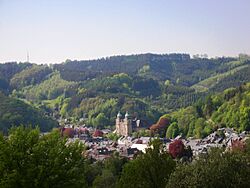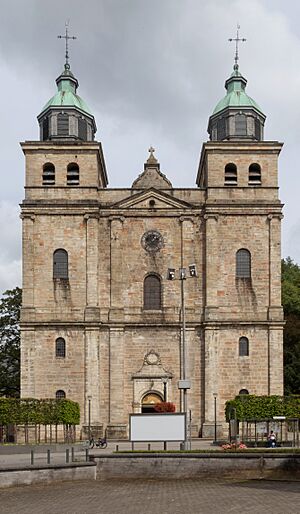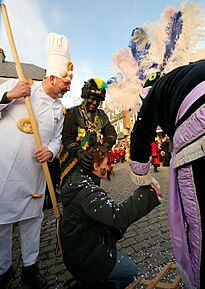Malmedy facts for kids
Quick facts for kids
Malmedy
|
|||
|---|---|---|---|

Malmedy from the south
|
|||
|
|||
| Country | Belgium | ||
| Community | French Community | ||
| Region | Wallonia | ||
| Province | Liège | ||
| Arrondissement | Verviers | ||
| Area | |||
| • Total | 99.96 km2 (38.59 sq mi) | ||
| Population
(2018-01-01)Lua error in Module:Wd at line 1575: attempt to index field 'wikibase' (a nil value).
|
|||
| • Total | Lua error in Module:Wd at line 1,575: attempt to index field 'wikibase' (a nil value). | ||
| Postal codes |
4960
|
||
| Area codes | 080 | ||
| Website | http://malmedy.be | ||
Malmedy is a lively city and municipality in Wallonia, a region in Belgium. It is located in the Liège Province.
As of January 1, 2018, Malmedy had about 12,654 people living there. The city covers an area of almost 100 square kilometers. This means about 127 people live in each square kilometer.
The municipality includes the areas of Bellevaux-Ligneuville, Bévercé (which has small villages like Baugnez and Xhoffraix), and Malmedy itself.
Belgium has special rules for how its regions are run. Malmedy is part of Wallonia and the French Community. This means French is the main language. However, Malmedy also has a small group of German speakers. Because of this, it is one of Belgium's "municipalities with language facilities." This means people can use German for some official things.
About 95% of the people in Malmedy speak French. Around 5% speak German. The German they speak is a special kind called Moselle Franconian.
Contents
Earthquakes in Malmedy
What are seismic risks?
Some parts of Belgium have more earthquakes than others. These areas include the provinces of Liège, Limburg, and Hainaut. Malmedy is in an area that is more likely to have earthquakes. It is in "zone 2," which is the most active earthquake zone in Belgium.
In 1692, a big earthquake happened near Verviers. It caused landslides, which are when large amounts of earth or rock slide down a slope. These landslides happened in the Warche valley, near Bévercé. Scientists found signs of these old landslides in 2015. This discovery helped them update the local maps of the ground.
Malmedy's Past
The name "Malmedy" comes from an old Latin phrase. It means "purifying from evil." This name came about because the Warche river, which flows through the town, used to flood often.
The city was started in the year 648 by a holy man named Saint Remacle. He was an abbot, which is a leader of a monastery. Saint Remacle built his monastery in Malmedy. For many years, Malmedy's history was connected to the Princely Abbey of Stavelot-Malmedy. This was a small state ruled by a prince-abbot.
For over 1,100 years, Malmedy and Stavelot were part of this special principality. Seventy-seven different prince-abbots ruled this area. However, the two towns often competed with each other. Saint Remacle had chosen Stavelot as the main city.
In the 1500s, many businesses started in Malmedy. These included making cloth, leather, and gunpowder. By the 1600s, Stavelot-Malmedy became famous for its leather production in Europe. But the most important business in Malmedy was making paper. This industry brought a lot of money to the town.
In 1795, during the French Revolution, France took over the Principality of Stavelot-Malmedy. Malmedy became a smaller administrative center in a French department.
After Napoleon was defeated in 1815, a big meeting called the Congress of Vienna took place. It was decided that Malmedy, which was a French-speaking town, would become part of Prussia. Prussia was a German state. This was a strange situation for Malmedy. For the first 50 years, the people were still allowed to speak French. They could even use French in town meetings.
Things changed after the Franco-German War in 1870. The German Empire was formed. The German government saw Malmedy as a problem. It was French-speaking and Catholic. So, the government, led by Otto von Bismarck, started a plan to make everyone speak German. French lessons were banned in schools. German became a must-learn language. Priests were also not allowed to preach in French.
During World War I, the people of Malmedy had to fight in German uniforms. But when Germany lost the war, Malmedy and other eastern areas were given to Belgium. This happened because of the Treaty of Versailles. The people in Malmedy and nearby Eupen had a vote to decide if they wanted to join Belgium. However, people who voted to stay with Germany had to write down their names and addresses. This made many German speakers feel scared. Both towns officially joined Belgium on March 6, 1925.
The main church in Malmedy was built in 1777. It was used as a cathedral from 1920 to 1925. Some older maps might show the city's name as "Malmédy" with an accent. This accent was added when it was part of Prussia and Germany. But today, the official name is "Malmedy," without the accent.
Between 1940 and 1945, during World War II, Malmedy was again part of Germany. In 1944, during the Battle of the Bulge, a sad event happened. It was called the Malmedy massacre. American soldiers who were prisoners of war lost their lives. This was done by Nazi SS troops. Other similar events happened in the Malmedy area.
On December 21, 1944, German forces attacked the town. American troops were holding Malmedy at the time. The American troops fought back and stopped the German attack. A few days later, on December 23, 24, and 25, 1944, the city was accidentally bombed by American planes. Many civilians lost their lives in these bombings. The number of American soldiers affected was never officially shared.
Today, the people of Malmedy have a mix of French and German cultures. Despite all the changes over time, the people of Malmedy are known for being friendly and welcoming. An English chemist in the 1700s described them as "honest, skillful, wealthy, gracious, sociable and courteous towards foreigners."
Malmedy has about 12,000 people living there now. The town is very musical! It has seven male choirs, two singing groups, four brass bands, an accordion club, and a mandolin club. There is also a very active music academy.
Languages Spoken in Malmedy
Malmedy is mostly a French-speaking city. Most people living there speak French as their first language.
However, because of its location and history, the German language is also important in Malmedy. Even though not many people speak German as their first language, it is still valued.
Walloon is the traditional language of the city. But today, only a few older people still speak it. It is becoming less common. However, Walloon is still heard in the folk songs of the Cwarmê (Carnival).
Malmedy's Weather
Malmedy has an oceanic climate, which means it has mild temperatures. But because it's inland and higher up, it also has some influences from a continental climate. This means winters can be cold. There can be days when the temperature stays below freezing. Strong frosts and snowfall are also common.
Malmedy gets a lot of rain. This rainy weather often affects the nearby Spa-Francorchamps race track. The track is known for its tricky weather conditions because of this.
| Climate data for Malmedy (1981–2010 normals; sunshine 1984–2013) | |||||||||||||
|---|---|---|---|---|---|---|---|---|---|---|---|---|---|
| Month | Jan | Feb | Mar | Apr | May | Jun | Jul | Aug | Sep | Oct | Nov | Dec | Year |
| Mean daily maximum °C (°F) | 3.0 (37.4) |
4.2 (39.6) |
7.9 (46.2) |
11.8 (53.2) |
16.2 (61.2) |
18.9 (66.0) |
21.1 (70.0) |
20.8 (69.4) |
17.1 (62.8) |
12.6 (54.7) |
6.9 (44.4) |
3.7 (38.7) |
12.1 (53.8) |
| Daily mean °C (°F) | 0.5 (32.9) |
0.8 (33.4) |
4.1 (39.4) |
7.0 (44.6) |
11.3 (52.3) |
14.0 (57.2) |
16.2 (61.2) |
15.8 (60.4) |
12.5 (54.5) |
8.9 (48.0) |
4.3 (39.7) |
1.3 (34.3) |
8.1 (46.6) |
| Mean daily minimum °C (°F) | −2.1 (28.2) |
−2.4 (27.7) |
0.2 (32.4) |
2.3 (36.1) |
6.4 (43.5) |
9.2 (48.6) |
11.2 (52.2) |
10.7 (51.3) |
8.0 (46.4) |
5.2 (41.4) |
1.7 (35.1) |
−1.0 (30.2) |
4.2 (39.6) |
| Average precipitation mm (inches) | 123.6 (4.87) |
104.1 (4.10) |
109.3 (4.30) |
79.5 (3.13) |
90.1 (3.55) |
97.4 (3.83) |
103.9 (4.09) |
97.6 (3.84) |
100.7 (3.96) |
102.3 (4.03) |
109.5 (4.31) |
128.9 (5.07) |
1,246.7 (49.08) |
| Average precipitation days | 15.3 | 13.3 | 15.1 | 11.9 | 12.6 | 12.9 | 12.7 | 11.9 | 12.2 | 12.7 | 15.0 | 15.9 | 161.4 |
| Mean monthly sunshine hours | 44 | 68 | 111 | 158 | 184 | 179 | 195 | 186 | 132 | 100 | 47 | 34 | 1,437 |
| Source: Royal Meteorological Institute | |||||||||||||
Fun Traditions and Festivals
The people of Malmedy are very proud of their Walloon language and their unique traditions. They love to celebrate! Some of the main festivals in Malmedy are the "Cwarmê" (Carnival), the "Saint-Jean d’été" (Midsummer's Day), the "Saint-Pierre" (a funfair for Saint Peter's Day), the "Saint-Géréon" (called "Tribodlèdje" in Walloon), and Saint Martin's Day ("Evêuyes").
The Cwarmê Carnival
The "Cwarmê" is the Walloon word for the Carnival of Malmedy. It is the town's biggest celebration. Even though Malmedy has some German culture, the "Cwarmê" is a Walloon and Latin carnival.
The carnival takes place for four days, from Shrove Friday to Shrove Tuesday. This is 40 days before Easter. The most important day is "Cwarmê" Sunday. On this day, tourists can see many old traditional costumes in the streets. About 2,500 people dress up! The "Cwarmê" is a "street carnival." This means it's not just a parade. People in costumes walk through the crowd and perform for everyone.
Here are some of the traditional costumes you might see at the "Cwarmê":
- The "Haguète" is the most beautiful and famous costume. She wears a big hat with colorful feathers. She uses long wooden tongs to gently catch a spectator's foot.
- The "Longuès-Brèsses" means "Long-arms" in English. This character is like a clown with very long arms. They use their arms to take a spectator's hat and put it on someone else's head.
- The "Long-Né" is a group of eight people. Each wears a long-nose mask, a blue smock, and a long red and white hat. They choose someone in the crowd to follow and copy. They keep doing this until the person offers them a drink!
Famous People from Malmedy
- Christian Brüls (born 1988), a football player.
- Joseph Doutrelepont (1834-1918), a German surgeon and skin doctor.
- Marie-Anne Libert (1782-1865), a scientist who studied plant diseases and fungi.
- Guido Maus (born 1964), a painter and sculptor.
- Henri Pousseur (1929-2009), a composer of music.
- Bernd Rauw (born 1980), a football player.
- Olivier Werner (born 1985), a football player.
- Raoul Ubac (1910-1985), a painter, photographer, and sculptor.
Images for kids
See also
 In Spanish: Malmedy para niños
In Spanish: Malmedy para niños














